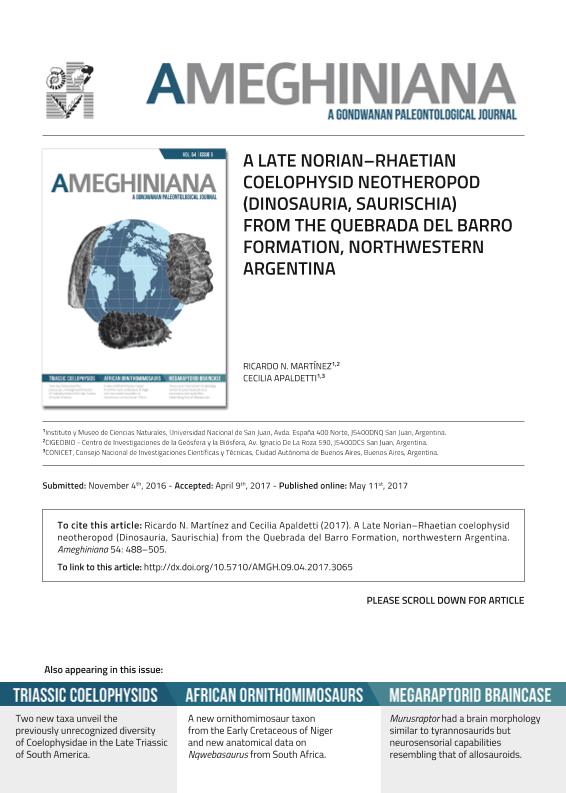Artículo
A late norian-rhaetian coelophysid neotheropod (dinosauria, saurischia) from the quebrada del barro formation, Northwestern Argentina
Fecha de publicación:
11/2017
Editorial:
Asociacion Paleontologica Argentina
Revista:
Ameghiniana
ISSN:
0002-7014
e-ISSN:
1851-8044
Idioma:
Inglés
Tipo de recurso:
Artículo publicado
Clasificación temática:
Resumen
Coelophysoids are the most abundant theropod dinosaurs known from the Late Triassic through Early Jurassic and represent the earliest major radiation of Neotheropoda. Within Coelophysoidea sensu lato, the most stable clade is Coelophysidae, which are small theropods characterized by long necks, and light and kinetic skulls. Coelophysids are the most abundant basal non-Tetanurae neotheropods known worldwide; however, until recently, they were unknown from South America. We report here a new coelophysid neotheropod, Lucianovenator bonoi gen. et sp. nov., from the late Norian-Rhaetian Quebrada del Barro Formation, northwestern Argentina. A phylogenetic analysis recovered Lucianovenator bonoi nested into the monophyletic group Coelophysidae in an unresolved clade, together with Coelophysis rhodesiensis and Camposaurus arizonensis. The presence of Lucianovenator in the late Norian-Rhaetian of Argentina increases the poor and scarce record of Triassic South American neotheropods, suggesting that the virtual absence of theropods in the fossil record during the Rhaetian is probably a taphonomic/stratigraphic bias instead of a decline in diversity and abundance after the Norian. Finally, the new finding corroborates the American endemism of coelophysid neotheropods in the Late Triassic and their worldwide distribution during the Early Jurassic, supporting the extreme faunal homogeneity hypothesized for Early Jurassic continental biotas.
Palabras clave:
Coelophysidae
,
Dinosauria
,
Marayes
,
Norian
,
Saurischia
,
Theropoda
Archivos asociados
Licencia
Identificadores
Colecciones
Articulos(CIGEOBIO)
Articulos de CENTRO DE INVESTIGACIONES DE LA GEOSFERA Y BIOSFERA
Articulos de CENTRO DE INVESTIGACIONES DE LA GEOSFERA Y BIOSFERA
Citación
Martínez, Ricardo Néstor; Apaldetti, Graciela Cecilia; A late norian-rhaetian coelophysid neotheropod (dinosauria, saurischia) from the quebrada del barro formation, Northwestern Argentina; Asociacion Paleontologica Argentina; Ameghiniana; 54; 5; 11-2017; 488-505
Compartir
Altmétricas




